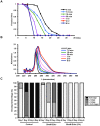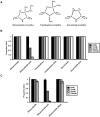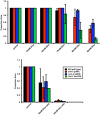UV-photoconversion of ethosuximide from a longevity-promoting compound to a potent toxin
- PMID: 24340038
- PMCID: PMC3858337
- DOI: 10.1371/journal.pone.0082543
UV-photoconversion of ethosuximide from a longevity-promoting compound to a potent toxin
Abstract
The anticonvulsant ethosuximide has been previously shown to increase life span and promote healthspan in the nematode Caenorhabditis elegans at millimolar concentrations. Here we report that following exposure to ultraviolet irradiation at 254 nm, ethosuximide is converted into a compound that displays toxicity toward C. elegans. This effect is specific for ethosuximide, as the structurally related compounds trimethadione and succinimide do not show similar toxicities following UV exposure. Killing by UV-irradiated ethosuximide is not attenuated in chemosensory mutants that are resistant to toxicity associated with high doses of non-irradiated ethosuximide. Non-irradiated ethosuximide extends life span at 15°C or 20°C, but not at 25°C, while irradiated ethosuximide shows similar toxicity at all three temperatures. Dietary restriction by bacterial deprivation does not protect against toxicity from irradiated ethosuximide, while non-irradiated ethosuximide further extends the long life spans of restricted animals. These data support the model that ethosuximide extends life span by a mechanism that is, at least partially, distinct from dietary restriction by bacterial deprivation and demonstrates an unexpected photochemical conversion of ethosuximide into a toxic compound by UV light.
Conflict of interest statement
Figures





Similar articles
-
The anticonvulsant ethosuximide disrupts sensory function to extend C. elegans lifespan.PLoS Genet. 2008 Oct;4(10):e1000230. doi: 10.1371/journal.pgen.1000230. Epub 2008 Oct 24. PLoS Genet. 2008. PMID: 18949032 Free PMC article.
-
Effects of anticonvulsant drugs on life span.Arch Neurol. 2006 Apr;63(4):491-6. doi: 10.1001/archneur.63.4.491. Arch Neurol. 2006. PMID: 16606760
-
Anticonvulsant medications extend worm life-span.Science. 2005 Jan 14;307(5707):258-62. doi: 10.1126/science.1105299. Science. 2005. PMID: 15653505
-
Pharmacology of delayed aging and extended lifespan of Caenorhabditis elegans.Exp Gerontol. 2006 Oct;41(10):1032-9. doi: 10.1016/j.exger.2006.06.038. Epub 2006 Jul 26. Exp Gerontol. 2006. PMID: 16872777 Review.
-
Mechanisms of life span determination in Caenorhabditis elegans.Neurobiol Aging. 1999 Sep-Oct;20(5):487-502. doi: 10.1016/s0197-4580(99)00087-1. Neurobiol Aging. 1999. PMID: 10638522 Review.
Cited by
-
Health and longevity studies in C. elegans: the "healthy worm database" reveals strengths, weaknesses and gaps of test compound-based studies.Biogerontology. 2021 Apr;22(2):215-236. doi: 10.1007/s10522-021-09913-2. Epub 2021 Mar 8. Biogerontology. 2021. PMID: 33683565 Free PMC article.
-
Ethosuximide ameliorates neurodegenerative disease phenotypes by modulating DAF-16/FOXO target gene expression.Mol Neurodegener. 2015 Sep 29;10:51. doi: 10.1186/s13024-015-0046-3. Mol Neurodegener. 2015. PMID: 26419537 Free PMC article.
-
A Caenorhabditis elegans assay of seizure-like activity optimised for identifying antiepileptic drugs and their mechanisms of action.J Neurosci Methods. 2018 Nov 1;309:132-142. doi: 10.1016/j.jneumeth.2018.09.004. Epub 2018 Sep 3. J Neurosci Methods. 2018. PMID: 30189284 Free PMC article.
References
-
- Mattson RH (1995) Efficacy and adverse effects of established and new antiepileptic drugs. Epilepsia 36 Suppl 2S13–26. - PubMed
-
- Rogvi-Hansen B, Gram L (1995) Adverse effects of established and new antiepileptic drugs: an attempted comparison. Pharmacol Ther 68: 425–434. - PubMed
-
- Kornfeld K, Evason K (2006) Effects of anticonvulsant drugs on life span. Arch Neurol 63: 491–496. - PubMed
Publication types
MeSH terms
Substances
Grants and funding
LinkOut - more resources
Full Text Sources
Other Literature Sources

